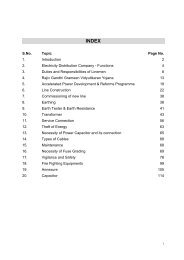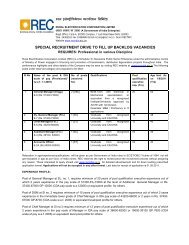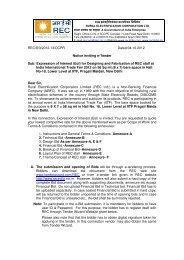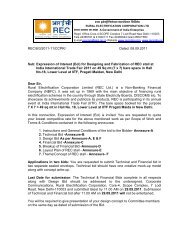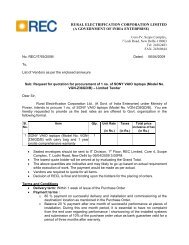REC- 1-51.p65 - Rural Electrification Corporation Ltd.
REC- 1-51.p65 - Rural Electrification Corporation Ltd.
REC- 1-51.p65 - Rural Electrification Corporation Ltd.
You also want an ePaper? Increase the reach of your titles
YUMPU automatically turns print PDFs into web optimized ePapers that Google loves.
40<br />
The performance orientation built into the R-APDRP is<br />
expected to incentivise and accelerate investments in<br />
distribution infrastructure, and result in faster<br />
accomplishment of loss reduction goals.<br />
Policy Environment in Power Sector<br />
The power sector reforms have evolved over a period of time.<br />
The introduction of Electricity Act, 2003 modified the legal<br />
framework governing the electricity sector, and set the stage<br />
for attracting capital for large scale power projects. The<br />
National Electricity Policy, was notified in February 2005,<br />
which defined the broad goals with the following key<br />
features (i) access to Electricity for all households in the next<br />
five years; (ii)energy and peaking shortages to be overcome<br />
and power demand to be fully met by 2012 (iii) Supply of<br />
reliable and quality power of specified standards in an<br />
efficient manner and at reasonable rates (iv) Minimum<br />
lifeline consumption of 1 unit / household / day as a merit<br />
good by year 2012 (v) Financial turnaround and commercial<br />
viability of the electricity sector; and (vi) Protection of<br />
consumer interests. The National Tariff Policy was notified<br />
in January 2006, which aimed to ensure financial viability<br />
of the power sector, attract investments, ensure availability<br />
of electricity to consumers at reasonable rates, and promote<br />
transparency and consistency in regulatory approach for<br />
tariff setting. An Appellate Tribunal for electricity also<br />
became functional since July 2005. Further, distribution<br />
reforms were identified as the key area to bring about the<br />
efficiency and improve financial health of the power sector.<br />
Among other various initiatives, the GoI approved a scheme<br />
called “Accelerated Power Development and Reforms<br />
Programme (APDRP)” in March 2003 which has been relaunched<br />
as R-APDRP by making it more performance-based<br />
and financially attractive. The <strong>Rural</strong> <strong>Electrification</strong> Policy<br />
was notified in August 2006, with the objective of improving<br />
access and quality of electricity supply in rural areas to<br />
ensure rapid economic development by providing electricity<br />
as an input for productive uses in agriculture, rural industries<br />
etc. The Rajiv Gandhi Grameen Vidyuthikaran Yojana<br />
(RGGVY) which was launched by the Government of India<br />
in April 2005 aimed to establish (i) <strong>Rural</strong> Electricity<br />
Distribution Backbone (REDB) with at least a 33/11 KV substation;<br />
(ii) Village <strong>Electrification</strong> Infrastructure (VEI) with<br />
at least one Distribution transformer in a village or hamlet;<br />
and (iii) Stand alone grids with generation where grid supply<br />
is not feasible. Subsidy towards capital expenditure to the<br />
tune of 90% is canalised through <strong>REC</strong>, which is a nodal<br />
agency for implementation of the scheme. <strong>Electrification</strong> of<br />
un-electrified Below Poverty Line (BPL) households is<br />
financed with 100% capital subsidy @ Rs. 1500/- per<br />
connection in all rural habitations as per Kutir Jyoti norms.<br />
The Management of <strong>Rural</strong> Distribution is undertaken through<br />
franchisees. A three-tier quality monitoring has been built<br />
into the scheme. RGGVY has thus resulted in huge<br />
investments in providing electricity connections in rural<br />
India.<br />
The regulatory environment has been quite dynamic in<br />
enabling the power infrastructure sector. During the year<br />
CERC amended the interstate Open Access regulations<br />
keeping in view its importance in carrying forward reforms<br />
in power sector. CERC also notified the Transmission License<br />
Regulations, 2009 which stipulate that the empowered<br />
committee shall identify the projects to be developed under<br />
the competitive bidding guidelines, as well as specify the<br />
41st ANNUAL REPORT 2009-10<br />
eligibility criteria, procedure and the terms and conditions<br />
for the grant of transmission license. CERC also notified Tariff<br />
Regulations for electricity generated from Renewable Energy<br />
sources, which are expected to promote new investments<br />
so that renewable electricity supply could expand. The<br />
normative Return on Equity has been specified at 19% (pretax)<br />
per annum for the first 10 years and 24% (pre-tax) per<br />
annum from 11th years onwards. Steps have also been taken<br />
to address the issue of mismatch between renewable<br />
resources availability in the local region and the renewable<br />
purchase obligations, as also to implement the Renewable<br />
Energy Certificate (<strong>REC</strong>) mechanism as an alternative route<br />
for fulfilling renewable purchase obligations.<br />
The above policy initiatives have addressed multifarious<br />
issues concerning the power sector in India and will continue<br />
to guide it to higher levels.<br />
2. OPPORTUNITIES<br />
The 11 th plan period (fiscal 2008-2012) target investments<br />
in power infrastructure stand at 10316 Billion INR. CEA<br />
estimates addition of 100000 MW generation capacity during<br />
the 12 th plan period (fiscal 2013- 2017) which together with<br />
related transmission and distribution infrastructure is<br />
estimated to require funding of over 11000 Billion INR.<br />
Therefore the power sector is expected to remain vibrant<br />
and attract significant investments in the foreseeable future.<br />
As a nodal agency for monitoring and channelizing funds<br />
under the RGGVY programme <strong>REC</strong> continues to take up the<br />
socio-economic responsibility of village electrification and<br />
contribute to the mission of ‘Power for all by 2012’.<br />
3. PRODUCT-WISE PERFORMANCE<br />
<strong>REC</strong> as a leading Public Financial Institution provides<br />
interest bearing loans to SEBs, State Power Utilities/State<br />
Power Departments and Private sector for development of<br />
all segments of Power infrastructure. The Company has<br />
already devised and continuously modifies/updates/extends<br />
loan portfolios to suit the emerging requirements of the<br />
borrowing power utilities.<br />
During the year, the Company has sanctioned loan assistance<br />
of Rs.45,357 crore and disbursed Rs.27,127 crore (including<br />
subsidy of Rs. 5,995 crore under RGGVY) in line with the<br />
mandate given by the Govt. enlarging the areas of operation<br />
of the Company to cover financing of all projects in Power<br />
Sector. The major component of the sanctions of the<br />
Company was for Generation schemes with total sanction<br />
amount of Rs.24,031 crore. In addition an amount of Rs.<br />
16,881 crore under Transmission and Distribution (T & D)<br />
schemes, Rs.4,090 crore under Short Term Loan, Rs.319 crore<br />
under IC & D projects and Rs.35 crore under RGGVY were<br />
sanctioned. The disbursement includes Rs. 8,349 crore under<br />
Generation, Rs.8,405 crore under T & D schemes, Rs.3,790<br />
crore under Short Term Loan and Rs. 6,583 crore (including<br />
subsidy of Rs. 5,995 crore) under RGGVY.<br />
4. THREATS, RISKS AND CONCERNS<br />
Our company has a significant concentration of outstanding<br />
loans to State Electricity Boards and State Utilities and if<br />
our loans to these borrowers become non-performing, the<br />
quality of our asset portfolio may be adversely affected. Our<br />
ability to borrow from various banks may be restricted by






